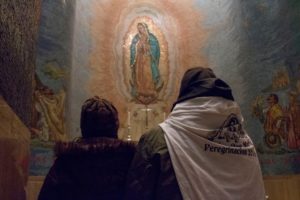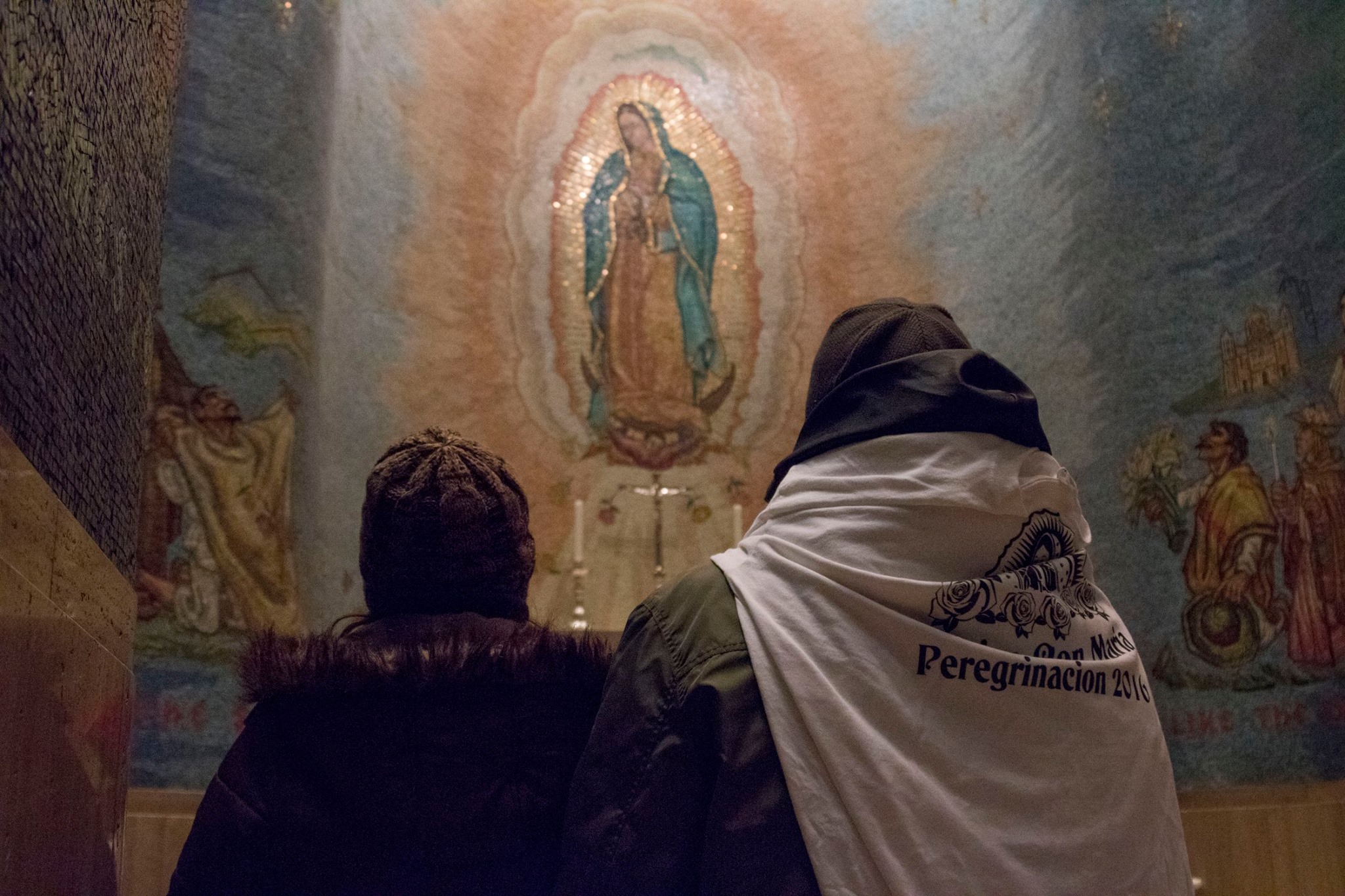 I’d like to reflect this evening on the first reading from today’s Mass for the Feast of Our Lady of Guadalupe.
I’d like to reflect this evening on the first reading from today’s Mass for the Feast of Our Lady of Guadalupe.
A great sign appeared in the sky, a woman clothed with the sun, with the moon under her feet, and on her head a crown of twelve stars. She was with child and wailed aloud in pain as she labored to give birth. Then another sign appeared in the sky; it was a huge red dragon, with seven heads and ten horns, and on its heads were seven diadems. Its tail swept away a third of the stars in the sky
and hurled them down to the earth. Then the dragon stood before the woman about to give birth, to devour her child when she gave birth. She gave birth to a son, a male child, destined to rule all the nations with an iron rod. Her child was caught up to God and his throne. The woman herself fled into the desert where she had a place prepared by God. Then I heard a loud voice in heaven say: “Now have salvation and power come, and the Kingdom of our God and the authority of his Anointed” (Rev 12:1-10).
I. Drama – In this great passage, there is a kind of a pulling back of the veil, a disclosure of what is really going on: There is a great and cosmic battle that reaches upward and outward, across generations, across nations and empires, and down into the close quarters of every human heart. It is the great battle between darkness and light, between the great Red Dragon and the Lord of Glory.
During this battle, there is a great sign in the heavens. There stands a woman clothed with the sun, the moon under her feet, and a crown of twelve stars about her head. She brings forth a son, destined to rule the nations with a rod of iron, to crush the dragon with the heel of his foot.
Many seek to localize the descriptions from the book of Revelation into either the first century or the end of time, but in fact they are fulfilled both then and now. For this great struggle was then, is now, and will continue until Christ comes again in glory to definitively apply the victory He has already won.
This great cosmic drama explains most of the struggles we see around us and within us. It explains the insanity of war, retribution, violence, promiscuity, abortion, sexual confusion and every evil afflicting us today. It explains our greed, our unreasonable fears and suspicions, our cynicism, and the fact that so often we are just plain mean to one another.
But this drama in the Book of Revelation also shows the woman clothed with the sun, Mary, and her son Jesus. And so it also explains our love, our thirst for justice, our appreciation for truth and beauty, and our capacity for caring, forgiveness, and living chastely and uprightly.
A wonderful documentary released in 2012, The Blood and the Rose, depicts this great drama. The title describes beautifully how in the midst of a bloody and violent world, the Lord often extends a rose, His mother.
There she is at the foot of the cross, with all its blood. There she is at the turning back of Muslim invaders at Lepanto. There she is at Guadalupe in the face of bloodthirsty Aztec gods. There she is at Fatima between two horrible wars.
But in the midst of all the blood and drama, the Lord extends a rose, His mother. Her message is never complex, it is simply the Gospel: repent and believe the good news. Yes, do whatever my Son tells you. Repent; forsake your evil ways. Come to a new mind and begin to live in the kingdom that is now available to you. As a good mother, she warns us and tells us to pray, pray, pray. During the blood of conflict and the dramatic battle between light and darkness, a rose: mother Mary.
II. Dramatis personae – The second thing that occurs to me is the cast of characters and the simplicity of the setting of the great drama. To whom does God extend the rose of His love at the beginning; to whom does Mary trust her message?
The pattern began with the incarnation itself. God sent Gabriel not to a powerful queen of this world, not to a woman of great access, power, or money. Rather He sent him to a humble maiden in a town so small that there was no road that even went to it. Nazareth, a town of 300, accessible only via footpath—that is where Gabriel was sent, and to a woman few had ever heard of—Mary of Nazareth. Some have described this is as a daring raid, conducted secretly behind enemy lines.
Down through the centuries, the pattern continued. Mary herself most often goes to the most hidden and humble of people: Juan Diego, a simple working man; Bernadette Soubirous, a peasant girl; and the three children young children of Fatima. None of these was a scholar, theologian, bishop, powerful businessman, king, queen, or prince. God chose the weak things of the world to shame the strong. God chose the lowly things of this world and the despised things—and the things that are not—to nullify the things that are, so that no one may boast before him (1 Cor 1:27-29).
We tend to think that solutions come through the great and powerful, through the “big cheeses” of the time. But the pride of this world will be conquered with humility; Heaven reaches out to the merest children. In the midst of the blood and horrible roar of war, the rose is extended quietly; its message goes forth to the humble.
III. Direction – A final matter to consider on this Feast of Our Lady Guadalupe is the direction to which it points. And frankly, it points to the south. The center of the Church has shifted south and her complexion has become browner.
As the lights are going out in the West and much of the developed world, many other lights are coming on: In Africa the number of Catholics has increased dramatically over the past fifty years.
Guadalupe somewhat signaled this all the way back in the 16th century. At the very time when Martin Luther was leading a revolt against the Church, at the very time when some two million Germans walked out of the church, nine million Mexicans walked in. In the midst of the bloody Aztec meltdown, in the midst of the blood feuds in Europe, Our Lady extended a rose in Mexico. The faith lit up in Mexico, Central America, and South America, even as it began its death throes in Europe.
In 1917 in Fatima, The Lord extended a rose through Our Lady. She warned three young children of a coming war that would be far worse than any that had ever been known before. She warned that if people did not repent and pray, Russia would spread her errors far and wide. But unlike 16th century Mexico, Europe did not heed her offer and disaster ensued, disaster that continues to unfold today.
Surely Africa, Central America, and South America are not without their problems. Protestant errors have infected too many. In Africa especially, many Catholics are being martyred at the hands of Muslims. There are still problems with government corruption and the lack of resources, but the blood of martyrs is the seed for the Church; it has always been so and will continue to be so until Christ comes again.
But in the midst of all the blood, in the midst of all the difficulties, God extends a rose to the poor and humble, the rose of His Mother Mary.
Happy Feast of our Lady of Guadalupe. For those of you who at times feel discouraged, remember the beautiful image of the blood in the rose. Stay calm and Viva Christo Rey!
Then I heard a loud voice in heaven say, “Now have salvation and power come, and the Kingdom of our God and the authority of his Anointed.”
Here is an old song based on an even older text that points to Mary at Guadalupe, whom many Mexicans call “La Morena,” the dark-skinned lady. The text (translated to English) says,
I am the little dark girl, I’m the dark girl.
It is said that darkness,
is caused by sin,
but sin was never found in me nor it will ever be.
I am the little dark girl, I’m the dark girl.
I am the thornless rose,
about whom Salomon rhapsodized:
I am black, and beautiful and for me they will sing.
I am the little dark girl, I’m the dark girl.
I am the flaming bush,
that burns but is not consumed,
nor am I touched by that fire that will touch the others.

